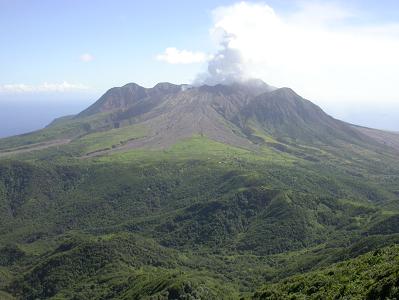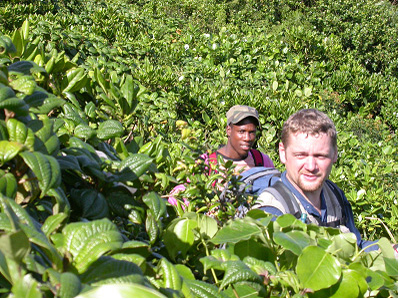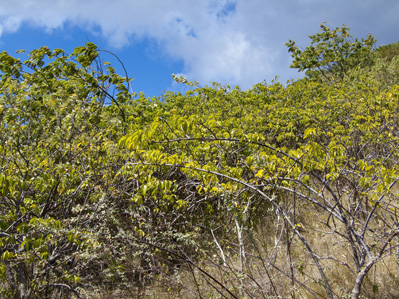


The vegetation of Montserrat is largely determined by the amount of rainfall, which is in turn closely linked to elevation. Therefore, the vegetation differs markedly from coast to mountain top. Littoral vegetation, influenced by wind and salt spray, occupies a narrow strip of land along the coast. Further inland, at lower altitudes and where rainfall is limiting, the vegetation consists of a mosaic of dry scrub, cacti dominated dry scrub and dry thicket. Stands of dry forest (seasonally deciduous sub-tropical woodland) occur in areas with low rainfall, usually along lower valleys and hill ridges and alongside seasonal stream beds. Mesic forest begins to appear as moisture becomes more available, usually at moderate elevations and further up along stream beds. Wet forests and tree fern breaks represent the climax vegetation at higher altitudes receiving greater than 1750mm of annual rainfall. As altitude and moisture availability increase the upper wet forest gives way to elfin woodland, a shrubby vegetation with an average height of 1.5 m.

There are about 700 plant species native to the island. Three are unique to Montserrat; Xylosma serratum (a member of the willow family, Salicaceae) which is now believed to be extinct; the orchid Epidendrum montserratense and a member of the coffee family (Rubiaceae), Rondeletia buxifolia. 70 species are endemic to the Lesser Antilles and half of these are restricted to six or fewer islands. Montserrat also supports four Caribbean endemic genera; Dendropemon (1sp.), Charianthus (1sp.), Tetrazygia (2spp.) and Tolumnia (1sp.).
Montserrat is recovering from a volcano that erupted several times between 1995 and 1997. The South Soufriere Volcano released devastating pyroclastic flows of hot ash, gas and rock. As well as destroying the capital, Plymouth, and several villages much of the surrounding vegetation was also destroyed (including the only known location of the endemic Xylosma serratum). However, the most southern part of the South Soufriere Hills, Roaches Mt. remains intact but inaccessible. Well over half of Montserrat's human population were evacuated from the island during the eruption and an area covering two thirds of the island is now an exclusion zone. During an expedition in 2006, a team lead by Kew staff found the remains of R. A Howard Collection, kept in the old Agriculture Department, now under ashes.

Perhaps the most threatened habitat in Montserrat is dry forest, due to its proximity to development and human activity. Most of the remaining dry forest is not afforded protection because it lies outside the boundary of the Centre Hills Forest Reserve. Historically, much had been cleared for agriculture or extracted for timber and charcoal. Now, stands of dry forest are restricted to the lower valleys and hill ridges and alongside seasonal stream beds. These areas are under threat from development for human habitation and services. In addition, regeneration is limited by overgrazing by livestock (namely goats) as well as competition by alien invasive weeds.
In dry-scrubland (dry scrub) areas where domestic livestock densities are at their highest, alien invasive plant species are rapidly spreading and outcompeting native shrubs which are unable to tolerate high grazing pressure. In the northern part of the island in the Silver Hills, large areas of scrub are dominated by Purple Allamanda (Cryptostegia madagascariensis), a garden escapee introduced from Madagascar.
Some plant communities in the Centre Hills are also at risk of local extinction. Elfin woodland is susceptible to climate change as it is restricted to a very narrow band along the peaks of hills and highest ridges. Alteration in temperature or changes in precipitation could dramatically impact upon this habitat because it will not be able to 'migrate' upwards to 'its' preferred environmental conditions.
Please use the links below to see further details on conservation activities in the UK Overseas Territories.
British Indian Ocean Territory
South Georgia and the South Sandwich Islands
Sovereign Base Areas on Cyprus
Homepage of the UKOTs Online Herbarium




